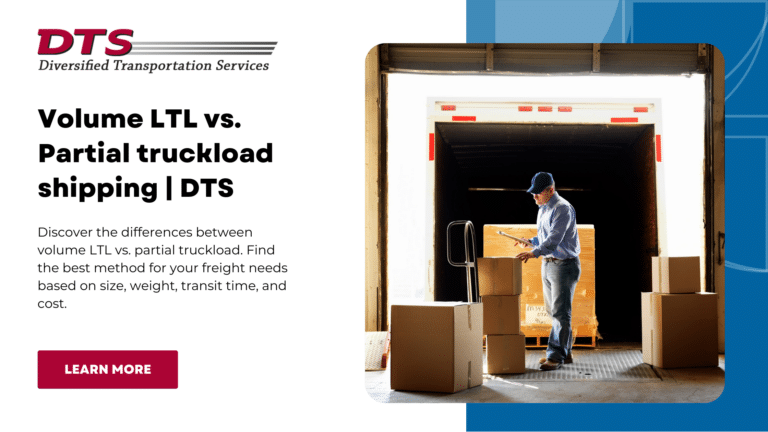
How do you transport freight that’s too big for standard less-than-truckload (LTL) shipping but still not big enough for the full truckload (FTL) method?
Volume LTL and partial truckload shipping are the go-to options in this situation. However, these shipping methods are fairly similar and can be difficult to tell apart. Understanding their differences and how they work will help you decide which option best suits your company’s shipping needs.
This post will explain those differences and help you choose volume LTL vs. partial truckload shipping.
Before we discuss volume LTL vs. partial truckload in detail, let’s define both shipping methods.
Volume LTL is used to move freight that exceeds the standard capabilities and requirements of LTL shipping. Essentially, it’s a less-than-truckload transportation method for shipments that are big but not so big that they need a full truck.
Partial truckload shipping is used to transport large shipments that take up more space than allowed with standard LTL shipping without needing a full truckload trailer. It falls between standard LTL and FTL.
Learn more about partial truckload shipping.
The following factors set volume LTL and partial truckload shipping apart.
You’ll need to consider size and weight carefully when exploring volume LTL vs. partial truckload shipping.
Volume LTL is generally used for shipments of between 6 and 12 pallets, weighing between 5,000 and 10,000 pounds. It’s used for shipments bigger than standard LTL shipping can accommodate but too small to qualify for a whole truckload.
Partial truckload is generally for bigger shipments of 8 to 18 pallets, weighing 8,000 to 27,500 pounds.
Volume LTL takes more time, as trucks make multiple stops, and loads may be transferred during the shipping process.
Partial truckloading is usually faster: it involves fewer stops and less cargo handling.
Volume LTL requires a freight class, but partial truckload doesn’t. Freight class significantly impacts shipping rates, based on the cargo’s size, stowability, and ease of handling.
Volume LTL rates are typically based on a carrier’s price tariff, according to the shipment’s weight, dimensions, and distance. However, carriers may offer discounts over standard LTL deals because of larger shipments.
Partial truckload charges tend to be flat rates. These are based on the amount of space required in a truck rather than the weight of the shipment and the distance it’s traveling.
Frequent handling is one of the most important factors to consider when choosing volume LTL vs. partial truckload shipping. Volume LTL shipments are usually transferred between trucks and terminals before they reach their destination.
Partial truckload shipments are handled less often than volume LTL freight. That often makes it the better option when transporting goods that are fragile or sensitive to movement for any reason.
If you use volume LTL to ship goods, your cargo will be consolidated and loaded onto trucks with other LTL shipments from the carrier’s other customers. That means loads from several senders may be bundled together onto the same truck.
Meanwhile, partial truckload shipments usually share trucks with just one or two other shipments.
There isn’t always a clear-cut choice between volume LTL vs. partial truckload shipping. Ultimately, your choice will depend on your shipping needs and your company’s priorities.
For example, if you have shipments that need to be delivered as quickly as possible, a partial truckload is probably the best method. Partial truckload involves fewer stops along the way with less handling, making journey times shorter than volume LTL.
Partial truckload also suits larger shipments that won’t fill a whole truck, and you won’t need to pay for the freight class.
However, if your organization is on a tighter budget, volume LTL may work better instead. It’s usually more cost-effective for slightly smaller shipments that don’t need to arrive as quickly when multiple stops don’t disrupt your operations. Just keep in mind that volume LTL involves freight class, which can make it less cost-effective.
You should always check carriers’ rates for both methods before you choose, and work with a shipping logistics company to get the best deal.
DTS can help you find the best option for your freight shipping goals with competitive rates — all backed by decades of experience. To get started, contact DTS today.
Whether you're a company looking to improve one facet of your supply chain, your entire supply chain, or simply looking for a transportation and logistics consultation, we can help.